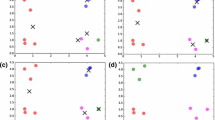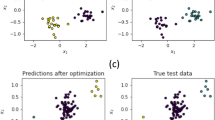Abstract
Clustering is grouping of data by the proximity of some properties. We report on the possibility of increasing the efficiency of clustering of points in a plane using artificial quantum neural networks after the replacement of the two-level neurons called qubits represented by the spins S = 1/2 by the three-level neurons called qutrits represented by the spins S = 1. The problem has been solved by the slow adiabatic change of the Hamiltonian in time. The methods for controlling a qutrit system using projection operators have been developed and the numerical simulation has been performed. The Hamiltonians for two well-known clustering methods, one-hot encoding and k-means, have been built. The first method has been used to partition a set of six points into three or two clusters and the second method, to partition a set of nine points into three clusters and seven points into four clusters. The simulation has shown that the clustering problem can be effectively solved on qutrits represented by the spins S = 1. The advantages of clustering on qutrits over that on qubits have been demonstrated. In particular, the number of qutrits required to represent \(N\) data points is smaller than the number of qubits by a factor of \(\log_{2} N/\log_{3} N\). For qutrits, the simplest is to partition the data points into three clusters rather than two ones. At the data partition into more than three clusters, it has been proposed to number the clusters by the numbers of states of the corresponding multi-spin subsystems, instead of using the numbers of individual spins. This reduces even more the number of qutrits (\(N\log_{3} K\) instead of \(NK\)) required to implement the algorithm.




Similar content being viewed by others
References
Biamonte, J., Wittek, P., Pancotti, N., Rebentrost, P., Wiebe, N., Lloyd, S.: Quantum machine learning. Nature 549, 195–202 (2017)
Dunjko, V., Briegel, H.J.: Machine learning & artificial intelligence in the quantum domain. Rep. Prog. Phys. 81, 074001 (2018)
Hunt, B.E.: Artificial Intelligence. Academic Press, New York (1975)
Arthur, D., Vassilvitskii, S.: k-means++: The advantages of careful seeding. Stanford. http://ilpubs.stanford.edu:8090/778/1/2006-13.pdf (2006). Accessed 2006
Lloyd, S., Mohseni, M., Rebentrost, P.: Quantum algorithms for supervised and unsupervised machine learning. arXiv preprint. https://arxiv.org/pdf/1307.0411.pdf (2013). Accessed 4 November 2013
Bauckhage, C., Brito, E., Cvejoski, K., Ojeda, C., Sifa, R.,Wrobel, S.: Ising Models for Biary Clustering via Adiabatic Quantum Computing. In: Proceeding of the EMMCVPR. Volume 10746 of LNCS., Springer (2017)
Kumar, V., Bass, G., Tomlin, C., Dulny, J.: Quantum annealing for combinatorial clustering. Quant. Inf. Process. 17(39), 1–14 (2018)
Wei, A.Y., Naik, P., Harrow, A.W., Thaler, J.: Quantum algorithms for jet clustering. Phys. Rev. D 101, 094015 (2020)
Mendelson, S.S., Strand, R.W., Oldaker IV, G.B., Farinholt, J.M.: Quantum-Assisted Clustering Algorithms for NISQ-Era Devices. arXiv preprint. https://arxiv.org/pdf/1904.08992.pdf (2019). Accessed 27 June 2019
Arthur, D., Prasanna, D.: Balanced k-means clustering on an adiabatic quantum computer. Quant. Inf. Process. 20(9), 1–30 (2021)
Pires, D., Omar, Y., Seixas, J.: Adiabatic Quantum Algorithm for Multijet Clustering in High Energy Physics. arXiv preprint. https://arxiv.org/pdf/2012.14514.pdf (2020). Accessed 28 December 2020
Albash, T., Lidar, D.A.: Adiabatic quantum computation. Rev. Mod. Phys. 90, 015002 (2018)
Harrow, A.W.: Small quantum computers and large classical data sets. arXiv preprint. https://arxiv.org/pdf/2004.00026.pdf (2020). Accessed 31 March 2020
Tomesh, T., Gokhale, P., Anschuetz, E.R., Chong, F.T.: Coreset clustering on small quantum computers. Electronics 10, 1690 (2021)
Tan, B., Lemonde, M.A., Thanasilp, S., Tangpanitanon, J., Angelakis, D.G.: Qubit-efficient encoding schemes for binary optimisation problems. Quantum 5, 454 (2021)
Das, R., Mitra, A., Kumar, S.V., Kumar, A.: Quantum information processing by NMR: preparation of pseudopure states and implementation of unitary operations in a single-qutrit system. Int. J. Quant. Inform. 1(3), 387–394 (2003)
Klimov, A.B., Guzman, R., Retamal, J.C., Saavedra, C.: Qutrit quantum computer with trapped ions. Phys. Rev. A 67, 062313 (2003)
Tamir, B.: Quantum query complexity for qutrits. Phys. Rev. A 77, 022326 (2008)
Zobov, V.E., Pekhterev, D.I.: Adder on ternary base elements for a quantum computer. JETP Lett. 89(5), 260–263 (2009)
Zobov, V.E., Shauro, V.P.: On time-optimal NMR control of states of qutrits represented by quadrupole nuclei with the spin I= 1. JETP. 113(2), 181–191 (2011)
Zobov, V.E., Ermilov, A.S.: Implementation of a quantum adiabatic algorithm for factorization on two qudits. JETP. 114(6), 923–932 (2012)
Zobov, V.E., Pichkovskiy, I.S.: Sequences of selective rotation operators to engineer interactions for quantum annealing on three qutrits. Proc. SPIE (2019). https://doi.org/10.1117/12.2521253
Choi, S., Yao, N.Y., Lukin, M.D.: Dynamical engineering of interactions in qudit ensembles. Phys. Rev. Lett. 119, 183603 (2017)
O’Keeffe, M.F., Horesh, L., Barry, J.F., Braje, D.A., Chuang, I.L.: Hamiltonian engineering with constrained optimization for quantum sensing and control. New. J. Phys. 21, 023015 (2019)
Wang, Y., Hu, Z., Sanders, B.C., Kais, S.: Qudits and high-dimensional quantum computing. Front. Phys. 8, 479 (2020)
Morvan, A., Ramasesh, V.V., Blok, M.S., Kreikebaum, J.M., O’Brien, K., Chen, L., Mitchell, B.K., Naik, R.K., Santiago, D.I., Siddiqi, I.: Qutrit randomized benchmarking. Phys. Rev. Lett. 126, 210504 (2021)
Zobov, V., Pichkovskiy, I.: Associative memory on qutrits by means of quantum annealing. Quant. Inf. Process. 19(9), 1–12 (2020)
Xu, Z., Yin, Z.Q., Han, Q., Li, T.: Quantum information processing with closely-spaced diamond color centers in strain and magnetic fields. Opt. Mater. Express. 9(12), 4654–4668 (2019)
Acknowledgements
This study was supported by the Theoretical Physics and Mathematics Advancement Foundation “BASIS” #20-1-5-41-1. We are grateful for their trust and assistance in research.
Author information
Authors and Affiliations
Corresponding author
Additional information
Publisher's Note
Springer Nature remains neutral with regard to jurisdictional claims in published maps and institutional affiliations.
Supplementary Information
Below is the link to the electronic supplementary material.
Rights and permissions
About this article
Cite this article
Zobov, V.E., Pichkovskiy, I.S. Clustering by quantum annealing on the three-level quantum elements qutrits. Quantum Inf Process 21, 144 (2022). https://doi.org/10.1007/s11128-022-03482-0
Received:
Accepted:
Published:
DOI: https://doi.org/10.1007/s11128-022-03482-0




